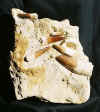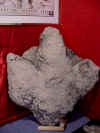MOSASAURUS TEETH
(Marine reptile, as in Jurassic World)
Sized and priced as shown. |
(1).JPG)
(1).JPG)
#DF233-103
1-1/2” long, no repairs
$22
|
(1).JPG)
(1).JPG)
#DF233-106
1-3/8” long, repaired
$18
|
|
.JPG)
.JPG)
#DF233-109
1-1/2” long, no repairs
$22
|
.JPG)
.JPG)
#DF233-111
1-3/8” long, repaired
$18
|
.JPG)
.JPG)
#DF233-112
1-3/8” long, repaired
$18
|
.JPG)
.JPG)
#DF233-113
1-3/8” long, no repairs
$22
|
.JPG)
.JPG)
#DF233-114
1-3/8” long, repaired
$18
|
.JPG)
.JPG)
#DF233-116
1-3/8” long, repaired
$18
|
.JPG)
.JPG)
#DF233-117
1” long, no repairs
$16
|
.JPG)
.JPG)
#DF233-118
1-1/8” long, repaired
$16
|
.JPG)
.JPG)
#DF233-119
1-1/8” long, no repairs
$16
|
.JPG)
.JPG)
#DF233-121
1-1/8” long, no repairs
$16
|

#DF233-125
1-1/4" long
$16
|

#DF233-131
1-1/8" long
$16
|

#DF233-132
1-1/4" long Repaired
$14
|

#DF233-133
1-1/4" long
$18
|

#DF233-134
1" long
$14
|

#DF233-135
1" long
$14
|

#DF233-136
1-1/8" long
$16
|

#DF233-137
1-1/8" long
$16
|

#DF233-138
1" long
$14
|

#DF233-139
1" long
$14
|

#DF233-140
1" long
$14
|

#DF233-141
1-1/8" long
$16
|

#DF233-142
1-1/4" long
$18
|

#DF233-143
1-1/4" long
$18
|

#DF233-144
7/8" long
$14
|

#DF233-145
1" long
$14
|

#DF233-146
1" long
$14
|

#DF233-147
1-1/8" long
$16
|

#DF233-148
7/8" long
$14
|

#DF233-149
1" long
$14
|

#DF233-150
1-3/8" long
$19
|

#DF233-151
1-1/8" long
$16
|

#DF233-152
1-1/4" long
$18
|

#DF233-153
1-1/4" long, repaired
$18
|

#DF233-154
1-1/4" long
$18
|

#DF233-155
1-3/8" long
$19
|

#DF233-156
1-3/8" long
$19
|

#DF233-157
1-3/8" long
$19
|

#DF233-158
1-5/8" long, repaired
$20
|

#DF233-159
1-3/4" long, repaired
$24
|

#DF233-160
1-5/8" long, repaired
$22
|

#DF233-161
1-3/4" long
$24
|

#DF233-162
1-3/4" long, repaired
$22
|

#DF233-163
1-5/8" long, repaired
$22
|

#DF233-164
1-1/2" long
$22
|

#DF233-165
2-1/16" long
$30
|

#DF233-166
1-1/2" long
$22
|

#DF233-167
1-3/4" long
$24
|

#DF233-168
1-3/4" long, repaired
$26
|






.JPG)
.JPG)
.JPG)
.JPG)
.JPG)
.JPG)
.JPG)
.JPG)
.JPG)
.JPG)
.JPG)
.JPG)
.JPG)
.JPG)

.JPG)
.JPG)
.JPG)
.JPG)
.JPG)
.JPG)
.JPG)
.JPG)



.JPG)
.JPG)
.JPG)
.JPG)
.JPG)
.JPG)
.JPG)
.JPG)
.JPG)

.JPG)
.JPG)







.JPG)
.JPG)
.JPG)
.JPG)
.JPG)
.JPG)
.JPG)
.JPG)
.JPG)
(1).JPG)
(1).JPG)
(1).JPG)
(1).JPG)
.JPG)
.JPG)
.JPG)
.JPG)
.JPG)
.JPG)
.JPG)
.JPG)
.JPG)
.JPG)
.JPG)
.JPG)
.JPG)
.JPG)
.JPG)
.JPG)
.JPG)
.JPG)
.JPG)
.JPG)












































.JPG)
.JPG)
.JPG)
.JPG)
.JPG)
.JPG)
.JPG)
.JPG)
.JPG)
.JPG)
.JPG)






